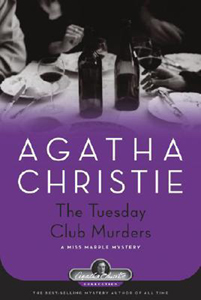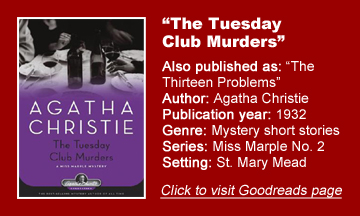In “The Tuesday Club Murders” (also known as “The Thirteen Problems,” 1932), Agatha Christie gives Miss Marple a collection of short stories to match – and surpass, actually – “Poirot Investigates.” I like this collection better, and I think it’s because it flows smoothly from story to story, with six people sitting around Jane Marple’s house in St. Mary Mead – at the invitation of her nephew, Raymond West – sharing mysteries from their own life experiences that the others must attempt to solve.
Perhaps to keep things fresh, the action later shifts over to a dinner party thrown by the Bantrys, where Marple — her reputation having gotten around – is invited for more rounds of this game. So readers get the amusing, and somehow not redundant, situation wherein Marple solves every case, often while knitting and always with genuine humbleness.
Engaging conversations
It goes against what one would assume, but the style wherein people tell the story verbally, conversationally, adds to “Tuesday Club’s” appeal. So that chapter’s storyteller might be quoting someone in his or her story, and therefore it requires a single quote mark within double quote marks, yet I never felt like the events lacked immediacy.
Christie has fun giving different personalities and storytelling styles to each club member; for example, actress Jane Helier – whose looks surpass her smarts — amusingly stumbles in her attempt to use “a friend of mine” as a stand-in for herself.
A modern reader gets a sense that maybe this is what people did for entertainment before the onset of radio. We know from other Christie books that they also play bridge (“Cards on the Table”) or a spiritual medium game that predated Ouija (“Murder at Hazelmoor”). Indeed, within the decent variety of “Tuesday Club’s” mysteries are a fair number with supernatural (or at least it’s suggested) elements.
Using her intuition
Marple is able to sort out in her brain what’s important and what’s unimportant – and who are potential killers and who are not. Marple does it on an intuitive level, based on her belief that people are not so different as they like to think they are – as such, observing human behavior in St. Mary Mead is as good as traveling around the globe.
She even remarks that humans’ unfounded belief that they are unique is why they repeat behavior (the pattern of a crime, for instance) that has been seen elsewhere.
Christie maintains Marple’s humbleness – that balance between not wanting to show off yet solving every mystery – by emphasizing her deep sense of justice. Somewhat shockingly, she believes in hanging murderers. And conversely, in the concluding case, “Death by Drowning,” she is deeply invested because she suspects the facts of the case are such that a smart (but not overly smart) police detective will finger an innocent person.
So she tells her friend, former Scotland Yard detective Sir Henry, who actually did it (humbly maintaining that it’s just a guess, and writing it on a slip of paper so readers aren’t spoiled) so he can see to it that an innocent person is not framed.

Good character piece
Whereas “Poirot Investigates” travels the globe and has all kinds of different cases, here we don’t have to rebuild with each chapter. “The Tuesday Club Murders” gives us 13 distinct cases, but it’s additionally an even better character-building piece for Marple than her novel debut in the excellent “Murder at the Vicarage,” and it outlines her philosophy on human nature.
(Note: Twelve of these stories debuted in a magazine prior to “Vicarage’s” 1930 publication. The first story, “The Tuesday Night Club,” marks Marple’s debut in December 1927.)
The camaraderie among the group is such that we as readers would wish to join a Tuesday night murder club if we lived in 1932. Heck, even today, it sounds more appealing than numbly scrolling through Facebook or a Netflix queue.
Every week, Sleuthing Sunday reviews an Agatha Christie book or adaptation. Click here to visit our Agatha Christie Zone.


